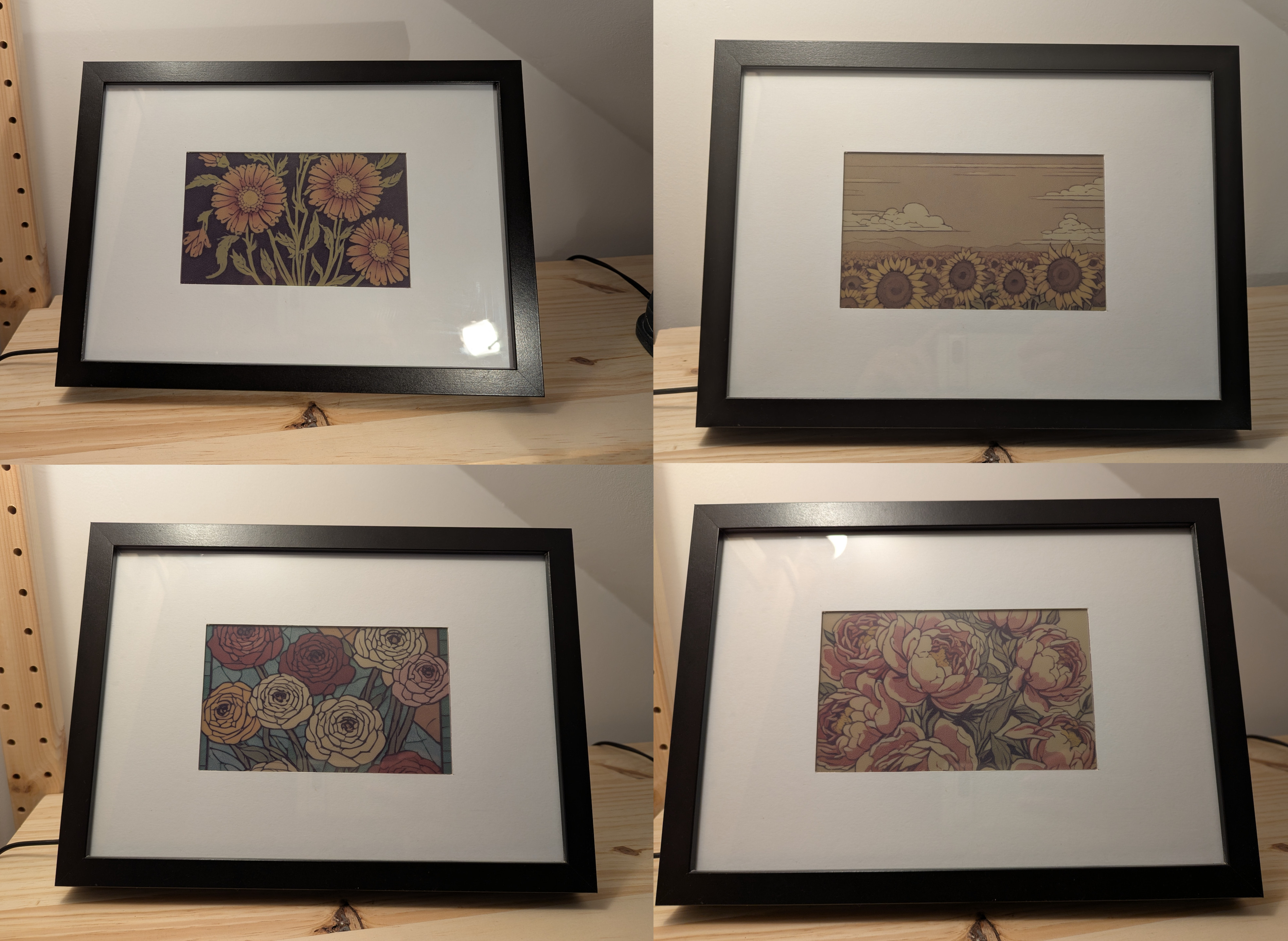PaperPiAI is a standalone Raspberry Pi Zero 2 powered e-ink picture frame running stable diffusion generating an infinite array of pictures.
This default set-up generates random flower pictures with random styles that I've found to work particularly well on the Inky Impressions 7.3" 7-colour e-ink display, i.e. low-colour palette styles and simple designs.
Once set up the picture frame is fully self-sufficient, able to generate unique images with no internet access until the end of time (or a hardware failure - which ever comes first).
Each image takes about 30 minutes to generate and about 30 seconds to refresh to the screen.
You can change the list of image subjects and styles to anything in generate_picture.py file. Ideally I'd like to generate the image prompts with a local LLM but have not found one that runs on the RPi Zero 2 yet. It would not have to run fast - just fast enough to generate a new prompt within 23 hours to have a new picure every day.
The display code uses salient spectral feature analysis to guide the crop (landscape or portrait) towards most intersting part of the square image that this stable diffusion model generates. It's not as good as diffusing directly for screen resolution but I don't know how to do that so this is my work-around.
- Raspberry Pi Zero 2
- Inky Impression 7.3" 7-colour e-ink display
- Picture frame, ideally with deep frame to accommodate RPi Zero
- Heatsink (optional) - I saw a max of 70°C (ambient was ~21°C) but one might be useful in a hot area or confined space
- Raspbian Bullseye Lite. A similar set-up ought to work with Bookwork (install inky 2.0 using Pimoroni's instructions) but I had odd slowdowns using Bookwork which I could not resolve.
Edit /etc/dphys-swapfile (e.g. sudo vim /etc/dphys-swapfile) and change the value of CONF_SWAPSIZE to 2048. You might be able to get away with a smaller swap size but it's been reported that the build process stalls with a swap size of 256.
Then restart swap with sudo /etc/init.d/dphys-swapfile restart
run sudo rasp-config and enable SPI interface and Ic2 interface
Firstly download this repo somewhere with:
cd ~/
sudo apt install git
git clone https://github.com/dylski/PaperPiAI.git
PaperPiAI/scripts/install.sh has all the commands needed to install all the required system packages, python libraries and OnnxStream - Stable Diffusion for the Raspberry Pi Zero.
If you are feeling brave then run install.sh in the directory you want to install everything, otherwise run each command manually.
The whole process takes a long time, i.e. several hours. If you are building in a RPi 4 of 5 you can speed it up by appendding -- -j4 or -- -all to the cmake --build . --config Release lines in install.sh. This instructs the compiler to use four cores or all cores, respectively. This speed up does not work on the RPi Zero 2 as it only has 512MB RAM.
Once installed, you need to edit the installed_dir path in PaperPiAI/src/generate_picture.py to point to you installed everything, i.e. where OnnxStream and the models folders were created.
Apologies for the rather manual approach - my install-fu is not up to scratch!
python PaperPiAI/src/generate_picture.py output_dir
Generates a new image and saves two copies to output_dir. One with a unique name based on the prompt, another as 'output.png' to make it simple to display.
Note that if you install the python packages into a virtual env (as the script above does) then you need to use that python instance, e.g.:
<install_path>/venv/bin/python PaperPiAI/src/generate_picture.py /tmp
To send to the display use python PaperPiAI/src/display_picture.py <image_name>. Use the -p flag if the display is in portrait mode.
To automate this I make a script that runs these two commands in sequence and put an entry in crontab to call it once a day.
All the generated images are currently retained locally. Each image is ~770KB, so generating an image every 24 hours for 3.5 years would take up ~1GB storage. If you are generating images at a faster rate and/or storage is limited then this would lead to issues.
I simple fix is to not save images with unique names, i.e. change this line from
fullpath = os.path.join(output_dir, f"{unique_arg}.png")
to
fullpath = os.path.join(output_dir, shared_file)
and comment out lines 90 - 92.
